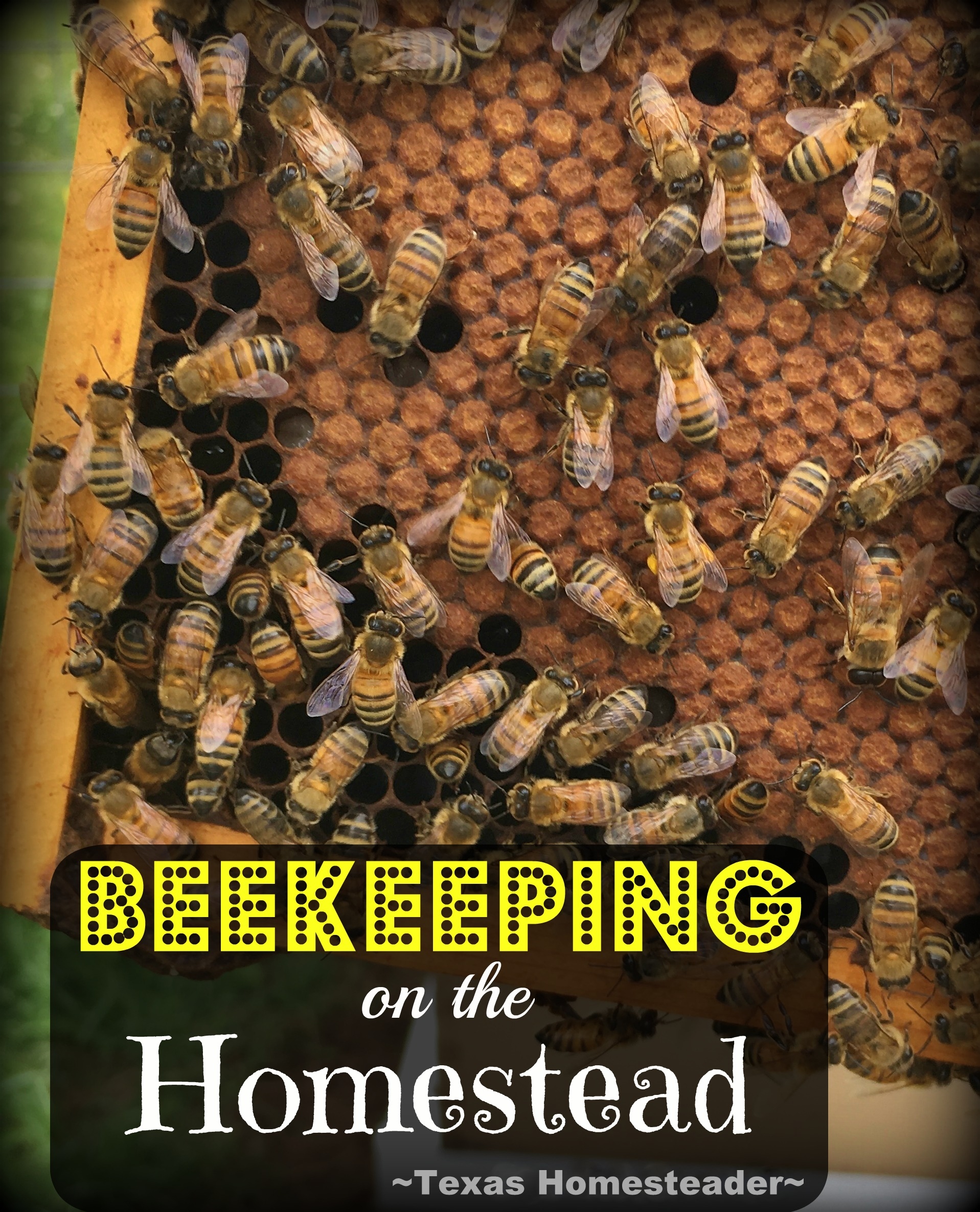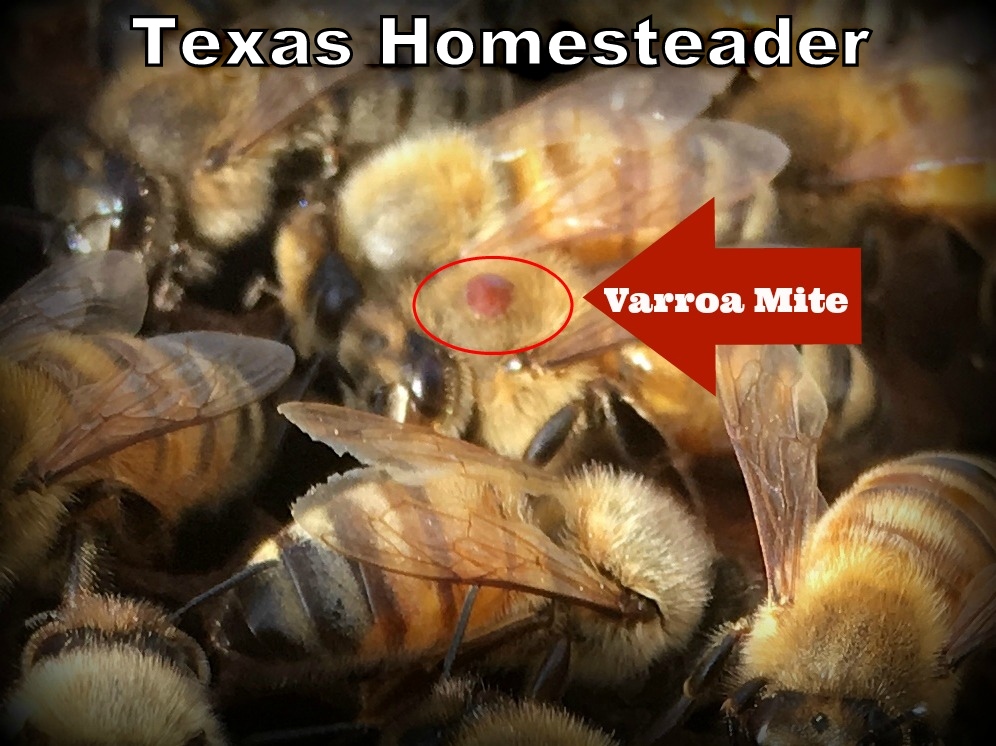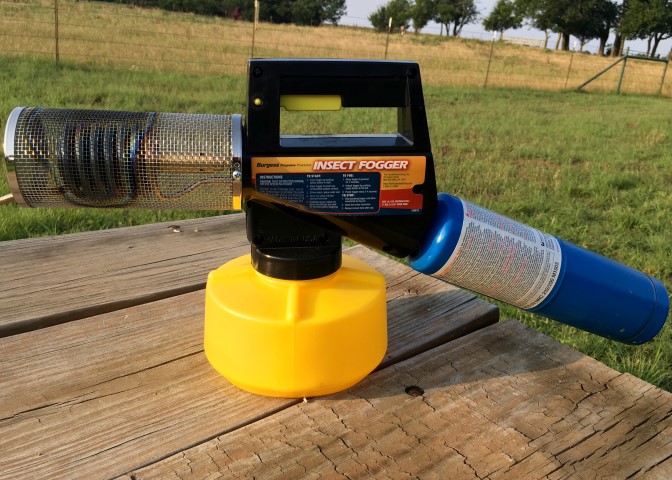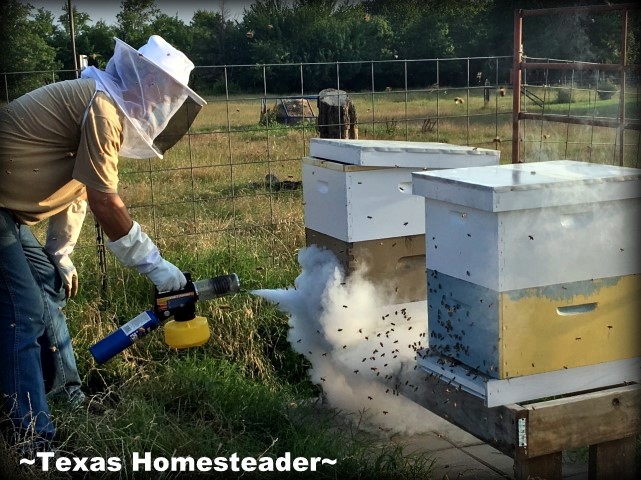by Texas Homesteader ~
contains affiliate link
Varroa Mites are a constant problem in beehives all over America. They are a small parasitic mite that will attach to the bee.
A female Varroa mite will enter a bee’s brood cell before it’s capped and lay her eggs there. By the time the bee emerges from her cell there are several mature Varroa ready to continue wreaking havoc on the hive.
The mite is large enough to see with the naked eye but DANG they’re still very small! But detection & treatment is important so into the hive we go!
One method I’m fond of using to scout for the little beasties is to go to the hives with RancherMan while he’s doing his inspections. Armed with my camera I’m able to get up close & personal taking pictures of the hive, the frames, the bees, etc. It’s not unusual for me to come back inside with a couple of hundred photos!
But these pictures also serve as a pictorial history of our hives as well as any changes from one inspection to the next.
PLUS I’m able to download the photos to my computer and really ZOOM in! At the most recent inspection as I was scouting for Varroa I saw this:
There were a few other bees that I was able to see which carried a mite as well. Now Varroa are tiny but they’re huge to the bee. I mean c’mon, if this bee were the proportional size of a human, that mite would be as big as a dinner plate!
After seeing this Varroa evidence, RancherMan & I decided to do a more thorough inspection for varroa mites using a sticky board. Although it showed our mite level is still low, we decided it was a good time to treat the hive.
(Note: Some links in this post are for further information from earlier posts I’ve written. But links preceded with * are affiliate links. If you click them and buy something (almost anything, not just the item noted) I could receive a small purchase. But the price you pay will NOT change. It’s an easy way to support this blog without anything coming out of your pocket. So click often! Thank you!)
Varroa Mite Treatment Options
There are various methods beekeepers use to treat their hives for Varroa:
- Thymol crystals (extracted from thyme oil)
- Powdered sugar – sprinkled into hive
- Various bee-safe chemicals & vaporizing applicators
We like to use the gentlest method of treatment first, then move on to the harsher treatments only if the more gentle treatment doesn’t offer the desired result. Although we’re not ruling it out, we’ve not yet been forced to take the chemical. We prefer more natural methods for treating Varroa.
Powdered Sugar Method Of Varroa Treatment
Some people use a shaker to shake powdered sugar into their hives. The bees will then clean each other to remove the sugar.
As a result of their cleaning they often clean the mites off each other as well. Some beekeepers don’t like to use commercial powdered sugar since it typically has cornstarch added to keep it from caking. Those beekeepers prefer to use granulated sugar that’s been placed in a blender and ground into a powder.
I don’t know whether or not we’ll personally bother with that step with our hives. Time will tell if we decide to use the sugar-shaker method in the future.
Thymol And Fogger Varroa Treatment
For now our favored method to treat Varroa is Thymol & food grade mineral oil in a propane-fueled fogger. Thymol is extracted from thyme oil and sold in crystal form. We’ll mix those crystals with food grade mineral oil.
Although it was very easy to find regular mineral oil, finding FOOD GRADE mineral oil was a challenge for us. So we bought it online and had it shipped directly to our home. Easy peasy! (We bought our fogger online at *WALMART . You can find *Thymol and food-grade mineral oil online at Amazon)
First of all RancherMan made a thymol mixture by blending 50 grams of pure Thymol crystals and 1000 cc’s (1/4 gallon) of food-grade mineral oil.
He loaded up his fogger with the mixture and put on his beekeepers veil. (no matter how docile your bees, never work the hive without at least having your veil on – eye stings are dangerous!)
Fogging The Hive With Thymol
When he got to the hive he didn’t want to disturb the bees any more than necessary. He cracked the top telescoping lid to offer an air flow-through and he pointed the fogger into the hive entrance and pressed the trigger to release the fog.
The fog goes into the hive and rises up through the frames and out the top, effectively treating the entire hive.
He went ahead and placed some fog under the telescoping lid as well just to make sure the hive was fully treated. Finally he closed everything back up and left the bees alone to allow them to settle.
It’s recommended once you fog the hive that you fog again two weeks later to treat the Varroa mites that have hatched since the last treatment.
Therefore RancherMan will wait 2 weeks and retreat with the fogger. He’ll then use the sticky board again to gauge the treatment effectiveness.
~TxH~
BEEKEEPING SERIES:
- Preparing For the Hives
- Obtaining Your Bees
- Inspecting Your Hives
- Feeding Bees With A Frame-Feeder
- Expanding The Langstroth Hive
- Performing A Walk-Away Split
- Performing A Frame-Swap Split
- 5-Minute Beehive Stand
- Adding A Honey Super To Your Hive
- Catching A Bee Swarm (With Video)
- Requeening A Beehive – Things We Didn’t Know
- FOUR 5-Frame Nuc Boxes From 1 Sheet of Plywood!
- Varroa Mite Treatment For Your Apiary
- Preparing Your Hive For Honey Harvest
- Proper Honey Bottling Tips
- Purifying Your Beeswax
- MYO Beeswax Lip Balm
- Homemade Beeswax Jar Candles
- Beeswax Wraps – A Natural Solution To Plastic Wrap
…And MUCH More!
See All Our Beekeeping Posts
C’mon by & sit a spell! Come hang out at our Facebook Page . It’s like sitting in a front porch rocker with a glass of cold iced tea. There are lots of good folks sharing! And you can also follow along on Pinterest, Twitter or Instagram
If you’d like to receive an email when a new blog post goes live,
subscribe to our Blog!
*Walmart affiliate – *Amazon affiliate






Now in July 2023…
Why do I not hear about this method much? It is amazingly cheap and quick and I’m curious why everyone isn’t using this method. Is it proven effective?
Fogging works beautifully for us. There are many methods of varroa mite control and treatment – everything from in-hive treatments to varroa resistant breeds of breeds. In beekeeping there are many variables that make every hive unique such as your area, type of hives, breed of bees, your maintenance preferences, etc. I’m sharing what works well for us. ~TxH~
How did the fogging go to help control the varroa mites?
It’s worked really well for us Jon. ~TxH~
I didn’t know about these. Thanks for informing me. I feel like the more I get into gardening/homesteading the more pests I’m learning about! Thanks for sharing on the Waste Less Wednesday Blog Hop.
Not that I ever, Never intend on setting up to be a bee keeper but have learned a lot by reading your bee blog updates.
Now; as for you Rancherman. You have A lot of guts not wearing the full bee suit. Bee wear, sooner or later you will get stung. Me; I would be decked out in a suit of armor, along with my Viking shield and all with bee suit underneath besides.
Never say never, Colleen. I was mortified when RancherMan suggested beekeeping. I’m terrified of bees!! But I wanted to stand by him in his endeavors and stand by him I did. I’ve learned many things about bees, and many of those things took away much of my fear. I now happily stand with him at the bee enclosure as the bees come in from water, them flying from behind to the hives before us. Their only focus is tending to the hive, not messing with me. ~TxH~
Wow! Who knew there was so much maintenance for a bee hive! Sort of like with having chickens. Lol. Would Thyme essential oil have worked too rather than crystals? That might be a good way to fog the greenhouse? OR would it leave an oily film? Maybe could fog with Thyme EO and water?
Anyway… Love the pictures and thanks for educating us. I have thought about beekeeping and this will help me determine if it would be something we could handle.
Yes you’re right Cheryl, there’s maintenance and health steps you have to take with bees just like you have to with chickens or any other critter. BUT if you’re thinking about bees know that RancherMan & I have really, really enjoyed having the bees. And, you know, this spring there’ll be HONEY! 🙂 I’d asked RancherMan about the thyme essential oil back when we were deciding on the method we’d use for the hives, but his research showed that thymol crystals are what’s needed, they’re more pure than EO. His research showed that EO is diluted and wouldn’t be an effective method of fogging. But thankfully we were able to find thymol online so we have a supply waiting for this hive-maintenance step. ~Tx~
Fascinating!